
- The Jin Dynasty 1115∼1234 AD
- The Yuan Dynasty 1279∼1368 AD
About Jin and Yuan
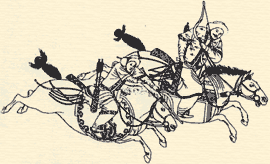
Mongol horsemen hunting
The Jin and the Yuan were neighboring nomadic non-Chinese tribes who lived in the north-east of the empire during the Song Dynasty before they developed their own powerful kingdoms. The Jin Dynasty was founded by a Tanguts tribe in 1115 AD and conquered the northern part of China in 1126 AD. This situation prevailed for more than one-hundred years until a strong Mongol army overthrew the Jin in 1234 AD. The Mongols then defeated the Southern Song in 1279 AD, taking over the whole region to found the vast Yuan Empire. During the time, China was totally under foreign rule and historians refer to the period as the Jin-Yuan.
In the 13th century, the Mongols rose to power under the leadership of Genghis Khan. Under his successor, his third son Ogodei (1227∼41 AD), as Great Khan, led Mongol armies into Europe as far as Poland and Hungary. In 1279 AD, it was the grandson of Genghis Khan, Kublai Khan, who founded the Mongol Dynasty, giving it the Chinese name of Yuan, and established his capital in Beijing. Under Mongol rule, the kingdom proved disjointed and divided. There were nine rulers who held the throne during this short period and as a result power was weakened. Chinese officials were once again able to gain a foothold when in 1368 AD a rebel Chinese group, the Red Turbans, ended the Yuan Dynasty.
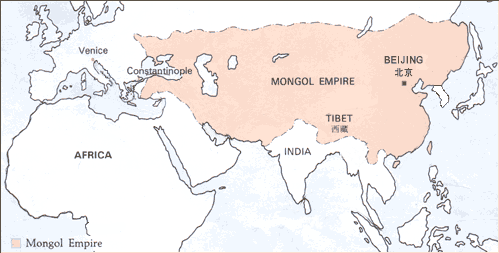
Territory of the Yuan
The culture, art and lifestyle of the country during the period remained basically the same as it had during the Song Dynasty, but the prosperity of the previous dynasty began to fade. The Jins wiped out some of the Song’s most talented artists. Creativity and inventiveness began to disappear. Under Mongol rule, a whole new set of rules and customs were created. The Mongols prohibited marriage between different ethnic groups and heavily taxed the peasants. In response to what they considered unjust and unfair treatment, a number of religious societies, including Buddhist-based associations, revolted.
On the positive side, Mongol rulers imposed a strictly regulated system of medical practice and banned the use of certain toxic drugs. In 1268 AD, for example, the sale of aconite and arsenic was forbidden. The Mongols also helped open trade in the region known today as the Middle East. One of the best-known explorers of the time was Marco Polo, a Italian-born explorer who was the first European to really journey through the Asian continent.
Prominent physicians
Several schools of thought evolved attributing to further understanding of disease development, and advocating contrasting approaches to treatment. This was in addition to the Mongol physicians who held their own set of beliefs. A number of physicians living at this time made a significant contribution to medical development.
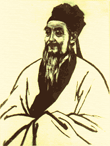
Liu Wansu (1120-1200 AD)
Liu Wansu – Fire and Heat Pathogens
Liu Wansu (1120∼1200 AD), or Master Hejian as his students called him, is credited with founding the Hejian School. A native of Hebei province, he three times turned down an offer from the Jin emperor to practice medicine for the palace and chose instead to practice medicine for the people. He played a significant role in the development of Chinese medicine and is famous for writing a number of works based on the medical classic, the Plain Questions.
Liu Wansu’s belief centered on the theory of the five movements and six influences, that changes in the natural world are closely related to the physiological and pathological aspects of the body. Physicians should consider the influences when treating their patients. He placed particular importance on the elements of fire and heat, and tended to prescribe herbs that have cooling properties to treat disease arising from these influences.This is also referred to as the “School of cooling” for the reason. Examples of his frequently prescribed herbs are cassia twig, rehmannia root, ephedra and mint.
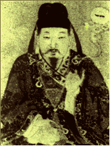
Zhang Congzheng
(1150 – 1228 AD)
Zhang Congzheng – Six Doors and Three Methods
Zhang Congzheng (1150∼1228 AD) had an innovative approach to medical treatment and insisted that the medicines of yesterday could not combat present-day illnesses. He was a military physician and wrote a book called Confucians’ Duties to Serve Their Parents) (ru men shi qin) based on his observations and research. However, he is best known for his theory of the “six doors and three methods.” The six doors are the six influences (wind, summer heat, dampness, fire, dryness and cold), and the three methods refer to therapeutic regimens used to induce sweating, vomiting and purging, that Zhang resorted to frequently. He thought that evil influences were derived from the heavens, earth and man's behavior (e.g. what he ate). In order to effect a cure, the evil influences had to be expelled.
Zhang Yuansu – Syndrome Differentiation of the Organs
Zhang Yuansu (1151∼1234 AD) was the founder of the Yishui School, named after his native district in Hebei province. According to his book Explanation of Medicine (yi xue qi yuan) published in 1186 AD, “the prescriptions of the past were not appropriate for the illnesses of today.” Zhang created a unique mosaic of his own practices and beliefs based on the teachings of his predecessors in medical classics such as the Yellow Emperor’s Classic of Internal Medicine, the Treatise on Cold-induced Diseases and Treasured Classics (zhong zang jing). Zhang Yuansu was known for his idea that medicine has specific effects on particular meridians. He thought illness occurred when there was an imbalance of zang and fu organs. By understanding the pathological conditions of the organs, a diagnosis could be made and appropriate therapy could be chosen. He created the guidelines of herbal applications for different disharmony patterns, which became the clinical routine of later.
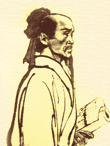
Li Gao (1180 – 1251 AD)
Li Gao – Treatise on the Spleen and Stomach
Li Gao (1180∼1251 AD), the Old Gentleman of Eastern Wall, had been fascinated by medicine since childhood. Li, who came from a wealthy family, is known for his concern about how lifestyle affects the body’s organs. In his most important work, Treatise on the Spleen and Stomach (pi wei lun), he stated that the spleen and stomach were the foundation of inborn qi, if they were damaged, vitality would decline and illness would result from an imbalance of inborn qi of organs. The main causes of spleen and stomach damages are improper diet, physically overworked, and over-stimulated emotions. He was a strong believer that a person’s emotions, including anger, joy, sadness and grief, could heavily influence the qi, and that illness was caused by a society marred by poverty, war and oppression. He created a serious of remedies to ensure qi flowing inside the body, and also invigorate the spleen and stomach functioning. Since he specialized in employing warming and invigorating methods to support the spleen and stomach, people called his work the “school of warming and invigorating.” He was a proponent of the use of several tonics and especially recommended ginseng.
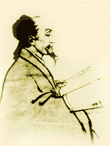
Zhu Zhenheng
(1281 – 1358 AD)
Zhu Zhenheng – Minister Fire
Zhu Zhenheng (1281∼1358 AD), also known as Master Danxi, was an innovated and insightful scholar in the Yuan Dynasty. He undertook a systematic study of medicine and his work, Supplementary Treatise on Knowledge from Practice (ge zhi yu lun), studies the theory of internal fire or heat during physiological and pathological change in the body. Minister fire is a vital force necessary for the body to function. Zhu Zhenheng thought that the body’s yang was usually in excess, causing yin to become deficient, and resulting in disharmonies. The minister fire, a kind of yang energy, could easily be irritated by external influences and acted rashly, which led to damages in body’s yin especially the essence. As a result, nourishing yin and quenching fire were important during treatment. His method of nourishing yin is still popular today in TCM. Zhu Zhenheng strongly recommended appropriate diet and sexual activities in order to preserve the body’s yin.
Acupuncture and Moxibustion

Location of Acupoint jiu wei
In the Jin-Yuan period, acupuncture and moxibustion were used extensively and various acupuncture points and their corresponding therapeutic virtues were validated further. Procedures in applying acupuncture and moxibustion had been developed differently over the centuries. Four Books of Acupuncture and Moxibustion (zhen jiu si shu) published by Dou Guifang in 1331 compiled important works written during the Song and Jin Dynasties on acupuncture. For example, a point known as jiuwei (see picture) mentioned was used in treatment of palpitations and epilepsy, a point whose use is endorsed by contemporary acupuncture practice for similar indications. It was not only the Chinese who made discoveries and developed new theories regarding acupuncture and moxibustion, the Mongols also contributed to the development of this kind of treatment. Applications like Mongolian moxibustion and blood-letting were very popular at that time.
Bone Setting and Traumatic Surgery
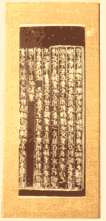
A copy from Effective Formulae Tested by Physicians for Generations
Nomadic Mongols were involved in continuous military activity and this further facilitated the development of external medicine. During the Yuan Dynasty, Qi Dezhi and his work Essentials of External Medicine (wai ke jing yi), dating from 1335 AD, represented the achievement of the time. The book outlines many surgical procedures for wounds or abscess, and lists remedies making use of concoctions, pills, powders and ointments. It is also a treatise on dermatology, he believed that disorders of the skin were a consequence of imbalance in yin and yang, phytotherapy (use of herbs) was an integral part of his approach. This book brings out new viewpoints on the causes, development and diagnosis of external diseases.
Wei Yilin (c. 1277∼1347 AD) a contemporary of Qi Dezhi specialized in orthopedics. His book Effective Formulae Tested by Physicians for Generations (shi yi de xiao fang) is a testimony to Wei’s skills in setting fractures and in treating dislocations of the shoulder, hips and knee joints. He also made occasional use of anesthetic drugs and pioneered the suspension method for joint reduction. It was not until 1927 that this was introduced into Western medicine by the British doctor, Davis.
Eating for Health the Chinese Way
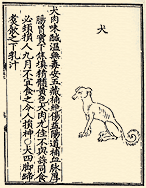
Dogmeat from Principles of Correct Diet
Hu Sihui, a Mongol, is credited for being a distinguished dietitian. He wrote Principles of Correct Diet (yin shan zheng yao) in 1330 and was a proponent of a balanced diet. He especially focused on the importance of moderation and championed the eating in moderation rule. In addition, Hu’s book offered a list of 230 cereals, meat, fish, shellfish, fruits and vegetables with a description of their nutritional benefits. For example, Hu said that eating too many apples caused distension and too many oranges could harm the liver; that dog meat was salty, not too overpowering, non-toxic and calmed the zang organs; and that grapes sustain energy and strengthen character.
Other Important Works
Other contributing practitioners during the Jin-Yuan period included Zeng Shirong, who wrote the Treatise for Children Life Saving (hou you xin shu) in 1294 AD, expanded the study of pediatrics from the Song Dynasty. Ge Keijiu (1305∼52 AD) who wrote a treatise in 1348 AD, A Miraculous Book of Ten Remedies (shi yao shen shu), was about tuberculosis and its treatment.
| Five Dynasties & Song :Previous | Index | Next: Ming Dynasty |


